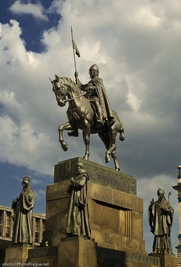
Saint Wenceslas
This preeminent Czech saint and patron saint of Bohemia was born around 907 at Duke Spytihnev’s court, but his father was the duke’s younger brother Vratislas. His mother was the strong and striking Duchess Drahomira, a supporter of the old ways, originally from the House of Havolan in the Polabi region.
Wenceslas received a very high education since his early age, which was unusual for that time. He was educated by Slavic priests and primarily by his grandmother, the widowed duchess Ludmila.
After the death of his father in 921, Wenceslas was 13 years old, so that the governance was taken over by his mother Drahomira. The murder of Wenceslas’ grandmother Ludmila by order of his mother is said to have happened around that time. Drahomira also greatly hindered the spreading of Christianity within the Czech princedom, which probably greatly contributed to the dissension between Wenceslas and his mother, since he had been raised a Christian. Wenceslas eventually took over command of the country in 925. Right at the beginning
of his reign he had to deal with the changing situation in Eastern Francia, where a new dynasty had ascended the throne, and with the growing power of Saxony, Bohemia’s age-old enemy. Wenceslas didn’t manage to withstand a military campaign against him in 929, he thus committed to pay the legendary tribute which is said by Cosmas to have amounted to 500 talents of silver and 120 oxen. The final years of Wenceslas’ rule were mostly marked by the increasing conflicts against the aristocracy, which sought support with his brother who became an instrument to achieve its aim. The aristocracy reproached Wenceslas his pro-Saxon policy, his active propagation of Christianity and his insufficient firmness against rivals. These clashes eventually reached the point when Boleslav tried to eliminate his brother, a goal he succeeded at in 935 (and not 929 as used to be believed).
The memory of Wenceslas as a martyr was already greatly honored in the 10th century and it later developed into the symbol of statehood and nationality.





